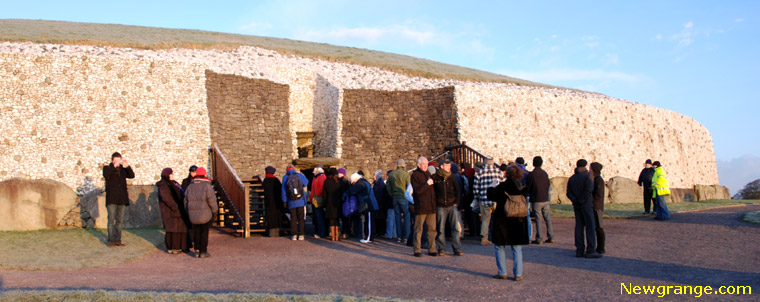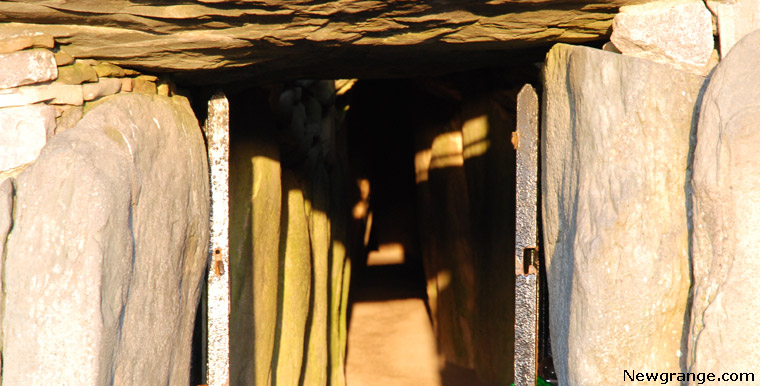The Boyne Inheritance
Published in The Irish Times 22 December 1980The annual pilgrimage to the great Meath necropolis of Newgrange, Dowth and Knowth at the winter solstice is of interest to more than archaeologists.
Whether these edifices in the Boyne Valley were primarily burial mounds or astronomical constructions or a combination of both will matter little to the man or woman in the street. What does matter is that the continuing study of these constructions and the teasing out of any details of the life of those who built them could be a useful addition to our knowledge of ourselves. For it will give us some perspective on our history; perhaps even induce some sense of humility into us.
Look at our present discontents. Some people date their origins back to the coming of the Normans in 1169: some to the Elizabethan wars and the Plantation of Ulster, to the Flight of the Earls or 1690; to the Act of Union or in any case, to Partition - to the Anglo-Irish settlement of 1921.
That is a span of a mere 800 years. Yet these Meath tombs were built some three thousand years before the Normans came; over two millennia before the Celts arrived from the European mainland. That these builders formed an organised, a sophisticated society, can hardly be denied. Even today Newgrange's artful construction has not allowed one drop of water to seep through into the main chamber.
They managed without metal tools, without the wheel; some of the stone came from far away. The savants tell us that they were a farming folk, probably as numerous as the present inhabitants of the area. And one thinker, Frank Mitchell, author of one of the seminal books on this country, The Irish Landscape has daringly worked out the number of men employed, the amount of earth and stone in the mound, and the number of days they would have needed to do the job.
There is nothing in a study of these remote people, their customs and presumed way of life to give us direst guidance on any of our problems of today. (Professor Estyn Evans has mischievously suggested that sectarianism may have raised its ugly head even then this he deduced from the different style of tomb-building which distinguished Ulster and the north-west form the rest of the island.)
Yet it is believed that some of our attitudes to life, some of our most ingrained habits, can be traced back to the pre-Celtic inhabitants. An American has even claimed that something like half of the genes in the Irish man or woman of today can be traced back to the oldest Mesolithic settlers i.e., even before the Boyne tomb-builders.
We have to live our own lives in our own way. But a respect for those ancestors of ours might help to still some of the more strident claims that the soil of Ireland belongs predominantly to one rather than the other of the peoples who have descended on this island.

The annual pilgrimage to the great Meath necropolis of Newgrange, Dowth and Knowth at the winter solstice
Newgrange and Dowth
Letter to The Irish Times, published 18 December 1980.Sir, Mr. Brennan (Irishman's Diary, December 11th) is to complimented on his enterprise and vigour. May I add one or two points to emphasis the value of his research?
Processor Kelly some time ago established that the winter solstice dawn-ray took four minutes before it entered the aperture prepared for it at Newgrange. Four minutes of time exactly represent one degree of movement. Experts assure us that owing to a persistent shift in the inclination of Earth's axis to the plane of the sun the solstice-angle has moved half a degree between 2000BC and the present roughly over 4,000 years. A shift of one degree therefore suggests that in the period circo 6,000 BC the sun-ray would have entered the aperature precisely at dawn. The assistance this gives to the problem of dating is as obvious as confirmation of the precision of early astronomic observation.
Mr. Brennan clearly appreciates that the sunset, as recorded by any type of gnomon, always occurs in exact opposite alignment to sunrise of the same day. The pattern of the Solstices therefore appears as a Saltire or Andrew Cross, or a kind of X. this is the basis of our own sitting on the 24-hour clock face of 8am and 4pm, 4am and 8pm to mark the conventional times of dawn and nightfall at, respectively, Winter and Summer Solstice. The alignment of prehistoric monuments, like Stonehenge, to the axis of Summer dawn and Winter sunset, the extreme points of the sun's decline and death and of its renewal and consummation, had a profound effect on the growth of our traditions of philosophy and religion. The Saltire of the Solstices, represented as the Labrys of the Minoans and Labarum of Constantime, is a symbol of men's unique relationship with the mystery of Creation. It is to be hoped that Mr. Brennan at Dowth will be able to confirm these points and attach even greater importance to ancient monuments in Ireland in general.
Yours etc.
Alun Llewellyn
52 Silchester Park,
Glenageary.
Boyne Valley Private Day Tour
 Immerse yourself in the rich heritage and culture of the Boyne Valley with our full-day private tours.
Visit Newgrange World Heritage site, explore the Hill of Slane, where Saint Patrick famously lit the Paschal fire.
Discover the Hill of Tara, the ancient seat of power for the High Kings of Ireland.
Book Now
Immerse yourself in the rich heritage and culture of the Boyne Valley with our full-day private tours.
Visit Newgrange World Heritage site, explore the Hill of Slane, where Saint Patrick famously lit the Paschal fire.
Discover the Hill of Tara, the ancient seat of power for the High Kings of Ireland.
Book Now
Home
| Visitor Centre
| Tours
| Winter Solstice
| Solstice Lottery
| Images
| Local Area
| News
| Knowth
| Dowth
| Articles
| Art
| Books
| Directions
| Accommodation
| Contact


